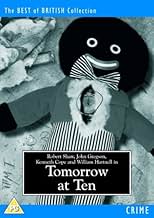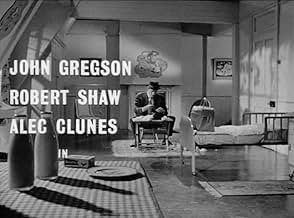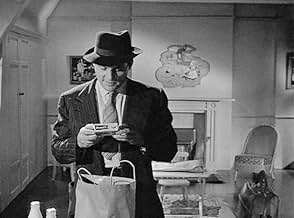VALUTAZIONE IMDb
6,8/10
519
LA TUA VALUTAZIONE
Aggiungi una trama nella tua linguaIt's a race against time for the police when they have to find a kidnapped boy imprisoned with a time bomb, after his abductor dies without revealing the child's whereabouts.It's a race against time for the police when they have to find a kidnapped boy imprisoned with a time bomb, after his abductor dies without revealing the child's whereabouts.It's a race against time for the police when they have to find a kidnapped boy imprisoned with a time bomb, after his abductor dies without revealing the child's whereabouts.
Recensioni in evidenza
When I watch a film like TOMORROW AT TEN, I'm a bit bemused because I can't understand why it's not better known. This is a cracking little thriller, one of the best of its era, and it really should be talked about today by film fans instead of being forgotten by all but the most dedicated viewers of the era. It's a pity that B-movie thrillers like this one are so little known as this sort of film more than holds its own against modern fare.
There's no padding or fat in this story which gets going from the outset. A delightfully mannered Robert Shaw (on the cusp of stardom in FROM Russia WITH LOVE, although TOMORROW AT TEN was made in 1962 and not released until 1965) plays a kidnapper who abducts the son of a rich businessman and locks him in a room with a bomb hidden inside a Golliwog. The boy's father and a local detective inspector must negotiate before the bomb explodes - 'tomorrow at ten'.
It's a great concept and the experienced director Lance Comfort makes a fine job of it. There's suspense in spades here, alongside plot twists you won't see coming and a delightfully tense race-against-the-clock (literally!) climax. The supporting cast includes notable roles for Kenneth Cope, Alec Clunes (father of Martin), Harry Fowler, William Hartnell, and Renee Houston. John Gregson's long-suffering detective inspector is one of the most sympathetic of his career.
There's no padding or fat in this story which gets going from the outset. A delightfully mannered Robert Shaw (on the cusp of stardom in FROM Russia WITH LOVE, although TOMORROW AT TEN was made in 1962 and not released until 1965) plays a kidnapper who abducts the son of a rich businessman and locks him in a room with a bomb hidden inside a Golliwog. The boy's father and a local detective inspector must negotiate before the bomb explodes - 'tomorrow at ten'.
It's a great concept and the experienced director Lance Comfort makes a fine job of it. There's suspense in spades here, alongside plot twists you won't see coming and a delightfully tense race-against-the-clock (literally!) climax. The supporting cast includes notable roles for Kenneth Cope, Alec Clunes (father of Martin), Harry Fowler, William Hartnell, and Renee Houston. John Gregson's long-suffering detective inspector is one of the most sympathetic of his career.
Suspenseful thriller in which Robert Shaw gets the lion's share as a kidnapper of a wealthy man's only son.The story almost entirely focuses on the villain and (it's rare ) tries to explain the reason why he did it .It's not only a matter of money as the viewer little by little discovers .The things themselves play a prominent part ,the ticking of the clocks or a jumping jack .The kidnapper is at hand ,under the police's eye ,like in more modern thrillers such as "oxygen" ;and of course there is a quarrel between the scared father and the police .The whole film is a race against the clock ,for the boy is in a house with a time bomb.
Not bad, especially because of the exceptional actor who was Robert Shaw. John Gregson is also very good, natural. All the actors are very good, which makes the film bearable, since everything is just talk, just boring dialogue.
The most telling points of this neat little British second feature, are the strong cast of Shaw, Gregson, Clunes, Wheatley and Cope, allied with a lively script and tight direction from Lance Comfort. The plot is tidy and unfussy and proceeds well towards its somewhat novel conclusion. Robert Shaw is excellent as the disturbed kidnapper, Marlow, and sterling support is provided by John Gregson as the police inspector. Some of the scenes are a little over the top, especially the one concerning the dancers in the nightclub, which by today's standards is quite hilarious! Not a classic by any means, but well worth watching in any event.
Just an errata and clarification for some of the above:
This little gem of a film is now under the ownership of Renown Films and is shown periodically on Talking Pictures TV (TPTV). The film was produced in 1962 as is confirmed by the titles (MCMLXII). It was released in 1963,but not well received, despite the presence of John Gregson who was a well known TV and film actor who often played the role of a police detective. However it was re-released in 1965, after Robert Shaw had appeared as the assassin Donald Grant in the second James Bond film From Russia with Love (1963). William Hartnel, who would subsequently play the first Dr. Who (1963 - 1966) also appears in a cameo as Freddie Maddox (frequently misspelled as Freddy), the father of George Marlowe (Maddox) and, with his wife Masie (Dorothy) Maddox are proprietors of The Golliwog Club.
Marlowe is not whistling the theme to Z-cars as he constructs the 'golliwog bomb', but rather is whistling the old English nursery rhyme 'Pop Goes The Weasel' and even sings a couple of lines. He is whistling an unintelligible song as he enters Abots Mead and walks up the stairs - as he approaches the second floor landing whistling can be heard in the background but it is evident from the shot that he is not whistling. The last segment as walks across the landing to the nursery does,however, resemble the theme tune of Z-cars.
The house from which Jonathan Chester is taken by the kidnapper is cited as being 14 Winnington Road, Hampstead, London N2. Whilst it is built in the neo-Georgian style of many of the larger houses towards the Highgate end of Winnington Road, it is certainly not the house which now stands there. It was in keeping with the area which wealthy financiers such as Anthony Chester (Alec Clunes) lived in the 50s and 60s.
The house at which Jonathan Chester (Piers Bishop) was kept hostage is portrayed as 'Abbots Mead' in Wimbledon, described by the estate agent, Mr. Tamplin (Frank Hawkins) as a detached house on three floors. Whilst the Wolseley police car is certainly seen driving at speed down the A3 expressway (now the Kingston Bypass) the actual location has not been verified.
This little gem of a film is now under the ownership of Renown Films and is shown periodically on Talking Pictures TV (TPTV). The film was produced in 1962 as is confirmed by the titles (MCMLXII). It was released in 1963,but not well received, despite the presence of John Gregson who was a well known TV and film actor who often played the role of a police detective. However it was re-released in 1965, after Robert Shaw had appeared as the assassin Donald Grant in the second James Bond film From Russia with Love (1963). William Hartnel, who would subsequently play the first Dr. Who (1963 - 1966) also appears in a cameo as Freddie Maddox (frequently misspelled as Freddy), the father of George Marlowe (Maddox) and, with his wife Masie (Dorothy) Maddox are proprietors of The Golliwog Club.
Marlowe is not whistling the theme to Z-cars as he constructs the 'golliwog bomb', but rather is whistling the old English nursery rhyme 'Pop Goes The Weasel' and even sings a couple of lines. He is whistling an unintelligible song as he enters Abots Mead and walks up the stairs - as he approaches the second floor landing whistling can be heard in the background but it is evident from the shot that he is not whistling. The last segment as walks across the landing to the nursery does,however, resemble the theme tune of Z-cars.
The house from which Jonathan Chester is taken by the kidnapper is cited as being 14 Winnington Road, Hampstead, London N2. Whilst it is built in the neo-Georgian style of many of the larger houses towards the Highgate end of Winnington Road, it is certainly not the house which now stands there. It was in keeping with the area which wealthy financiers such as Anthony Chester (Alec Clunes) lived in the 50s and 60s.
The house at which Jonathan Chester (Piers Bishop) was kept hostage is portrayed as 'Abbots Mead' in Wimbledon, described by the estate agent, Mr. Tamplin (Frank Hawkins) as a detached house on three floors. Whilst the Wolseley police car is certainly seen driving at speed down the A3 expressway (now the Kingston Bypass) the actual location has not been verified.
Lo sapevi?
- QuizAbbots Mead, the disused Victorian house (referred to in the film by its real name) where Marlow takes Jonathan after he has kidnapped him, was bought by film director Stanley Kubrick shortly after this film was made. He and his family lived there from 1965-1979 and he edited many of his films, such as A Clockwork Orange, in an outbuilding alongside the house.
- BlooperWhen Parnell and Grey first meet the local police officer near Chester's house, a cylindrical microphone windshield is very obvious at the bottom of the frame.
- ConnessioniFeatured in Tienes que ver esta peli: Mañana a las 10 (2022)
I più visti
Accedi per valutare e creare un elenco di titoli salvati per ottenere consigli personalizzati
- How long is Tomorrow at Ten?Powered by Alexa
Dettagli
- Data di uscita
- Paese di origine
- Lingua
- Celebre anche come
- Tomorrow at Ten
- Luoghi delle riprese
- 91 Winnington Road, Hampstead, Londra, Inghilterra, Regno Unito(14 Winnington Road - the Chesters' house)
- Azienda produttrice
- Vedi altri crediti dell’azienda su IMDbPro
- Tempo di esecuzione1 ora 20 minuti
- Colore
- Proporzioni
- 1.37 : 1
Contribuisci a questa pagina
Suggerisci una modifica o aggiungi i contenuti mancanti

Divario superiore
By what name was Tecnica di un crimine (1963) officially released in India in English?
Rispondi































